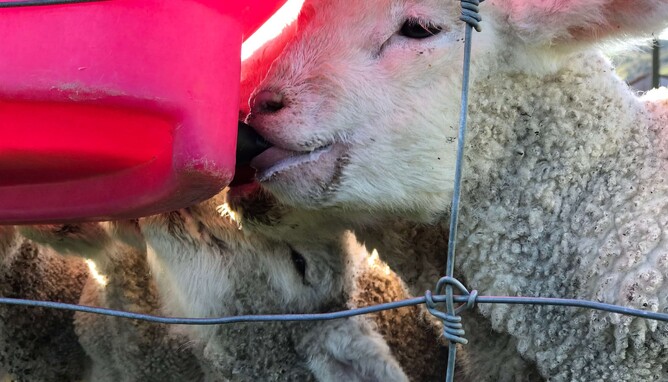Here's a summary of conditions we recommend for best health outcomes when rearing lambs.
From day one, the essential conditions and requirements are:
A warm, dry, draft free and clean space.
Fresh straw/hay and meal/muesli feed.
Tube 3x 250ml colostrum feeds within the first 24 hours.
If lamb is weak/comatose, inject dextrose into abdomen (this must be done before warming the lamb up), tube colostrum into the stomach, and place in a warmer or under heat lamps.
Spray every naval with iodine and treat swollen ones with 1ml penicillin, injected daily for five days (if they get an infection later or joints are infected treat with 2-3ml every 48 hours).
Scratch every lamb ONLY IF scabby mouth is present on farm.
When feeding lambs inside:
Lambs need 10-15% or their body weight of milk daily.
Milk should be 35-40 degrees (which feels very warm).
They should be fed at least three times a day until around two weeks old, then can be reduced to two times a day and once a day from three weeks old.
They will initially need to be individually fed with a bottle before being transitioned onto a feeder from around two days old. This should still be monitored to ensure all lambs are fed equally.
Keep the pens as clean and germ free as possible by spraying weekly with disinfectant.
Transitioning to feeding outside:
When consuming 100 grams of meal a day they can go out to grass – this is usually around three weeks of age.
When consuming 200 grams of meal a day (or when 10-12kg or 4-5 weeks old) they can be weaned.
When consuming 400-700 grams of meal a day (or when 20kg or 8-10 weeks old) they can move to only consuming high quality pasture (no less than 1600kg DM/ha).
Estimated total feed per reared lamb: 5kg milk replacer and 20kg meal.
Look out for bloat:
Bloat is the biggest cause of death in reared lambs. It usually occurs from 3-4 weeks old and it happens 1-2 hours after drinking a sudden gorge.
Treat with 3ml penicillin orally ASAP or inject directly into the gut.
If the lamb is about to die, as a final resort, hold the lamb on it’s back and insert a 16G 1 inch needle straight into the stomach by placing it on the midline in between the end of the sternum and the navel. Then give 1ml penicillin/10 kg into the muscle.
To prevent bloat, keep lambs on twice daily feeding until weaning, and try adding 10-15 grams of baking soda or yoghurtised milk. Alternatively, the use of whey based milk replacers have also been shown to reduce the incidence of bloat.
Additional tips:
Watch the lambs when using the feeder early on and re-group them into slow and fast drinkers.
Using a soft teat initially and moving onto a hard teat will help lambs learn to suckle.
If ad lib feeding there should be at least one teat per five lambs, milk should be fed cold (to restrict intake) and the feeder shouldn’t be empty for more than two hours.
If needing to feed cows milk, remember that it has lower energy and fat, but higher lactose. Therefore it should be altered for lambs by adding lamb milk replacer at 75 gram/litre or yoghurtising the milk.
If a lamb is scouring, try feeding an electrolyte solution in between milk feeds (an ensure fresh water is always available too).
Assume orphan lambs have no maternal protection against Clostridia. They should therefore be given three doses of a 5-in-1 vaccine, with an additional first dose earlier than other lambs.

